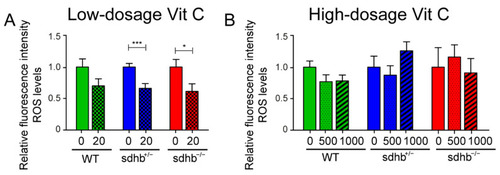Figure 4
- ID
- ZDB-FIG-211029-214
- Publication
- Dona et al., 2021 - Targeting the Redox Balance Pathway Using Ascorbic Acid in sdhb Zebrafish Mutant Larvae
- Other Figures
- All Figure Page
- Back to All Figure Page
|
Reactive oxygen species (ROS) measurements after a low- and high-dosage Vitamin C treatment. Relative average fluorescence levels are shown normalised to control levels without Vitamin C supplementation. (A) Larvae were supplemented with 20 mg⋅L−1 Vitamin C homozygous sdhb (n = 22), heterozygous sibling (n = 33), and wild-type sibling (n = 21) compared to the control group (indicated with 0 mg⋅L−1) consisting of homozygous sdhb larvae (n = 24), heterozygous sibling (n = 38), and wild-type sibling (n = 18) from two different replicates measured at 6 dpf. Low-dosage levels of Vitamin C significantly decreased ROS levels in heterozygous and homozygous sdhb larvae compared to the untreated control group. (B) Larvae were supplemented with 500 mg⋅L−1 Vitamin C homozygous sdhb (n = 12), heterozygous sibling (n = 24), and wild-type sibling (n = 18); 1000 mg⋅L−1 Vitamin C homozygous sdhb (n = 8), heterozygous sibling (n = 22), and wild-type sibling (n = 22) compared to the control group (indicated with 0 mg⋅L−1) consisting of homozygous sdhb larvae (n = 10), heterozygous sibling (n = 14), and wild-type sibling (n = 16) from three different replicates measured at 6 dpf. High-dosage levels of Vitamin C did not alter ROS levels in all three genotypes compared to the untreated control group. Two-tailed unpaired Student’s t-test, * p < 0.05 and *** p < 0.001. |

